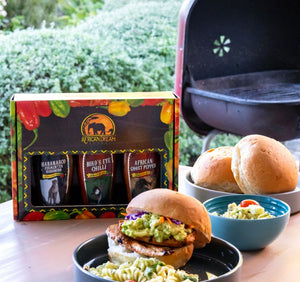What is “Umami” and Why It’s a Thing
Dec 17, 2022
In the late 20th century, a Japanese scientist coined the term “umami” to denote a particular food flavor. But what is umami? Where the other four basic tastes are straightforward, umami is difficult to define. However, we’re up to the challenge, so let us tell you about the umami taste, meaning, history, and more.

What Is Umami?
The Japanese word “umami,” meaning “pleasant savory taste,” is also called monosodium glutamate. It has been identified as the fifth basic taste, the other basic tastes being sweet, sour, salty, and bitter. To elaborate, Japanese scientists discovered umami taste receptors on the human tongue along with the other basic tastes.
These five basic tastes are crucial to food safety and quality. For instance, sweet foods alert you to the consumption of carbohydrates, which should energize you. Bitter foods make you consider if something is toxic. But what concerns us is umami, which signals to your brain that you’ve consumed protein and amino acids.
What Is the Flavor of Umami?
After all, you’re here to understand the umami flavor. What is it if it isn’t exactly sweet, sour, salty, and bitter? Umami is meaty and savory, with a very elemental yet complex taste. Additionally, it has a mild but lasting aftertaste.
To illustrate, it lasts longer than other basic tastes, spreads all over the tongue, and has this mouthwatering sensation. Not to mention, it stimulates the throat, roof, and back of the tongue.
What Does Umami Do to the Body?
Let’s go into the science behind the umami taste. Simply put, the meaty and savory flavor comes from glutamate, guanylate, and inosinate. Glutamate is either unbound or bound to other amino acids in proteins; the unbound ones are the route of this umami taste.
To illustrate, they bind to your taste receptors. This explains the savory taste, which stimulates your body to secrete more saliva and digestive liquids. Accordingly, it’s ready to digest the proteins you’ve consumed.
Why Is Umami a Thing?
Let’s look at the history of umami to understand how it came to be. In 1908, as the Japanese scientist Dr. Kikunae Ikeda was having Kombu dashi, a Kelp broth, he noticed its savory taste wasn’t sweet, sour, salty, or bitter. So, he coined the term “umami” to describe this fifth basic taste.

In 1985, the Umami International Symposium assessed umami according to a set criteria. Its research confirmed that umami has its distinct receptors on the taste buds and that it’s an independent flavor rather than the result of combining other tastes.
Accordingly, the Society declared “umami” the scientific term for this distinct taste category, the fifth flavor. And with the rise in research about it, the popularity of umami increased.
What Food Has the Most Umami?

This is a good question because the umami taste may or may not be subtle. So, we’ll pinpoint the best examples of umami foods.
Firstly, aged cheeses have high levels of glutamate because they have more broken-down proteins than regular ones, which inherently means more free glutamate and umami. In other words, they’re fermented foods that naturally have the taste of umami.
Although you can eat cheese on its own, you can also find such umami-rich foods in other dishes. For example, you can enjoy pasta with parmesan cheese on top or a charcuterie board with various cheeses.
Secondly, tomatoes are some of the main umami foods, thanks to their high glutamic acid ratio. Like cheese, they’re naturally umami rich. This also applies to fire-roasted tomatoes. Either type of tomato enhances the original flavors of many foods, such as pasta and pizza.
Thirdly, meats, including steak and beef, are a source of IMP. When you combine them with amino acids, this creates a synergistic effect, which enhances the umami taste. Additionally, when you cure meat, it breaks down its proteins and creates free glutamate compounds. Cooked meats are also umami-rich foods. We can’t say the same for fresh meat, though.
Fourthly, believe it or not, breast milk has high levels of amino acids, which gives it the taste of umami. Just think about how breast milk is the first form of nutrition a baby may receive and their first taste memory, which explains why they might subconsciously look for it throughout their adult life.
What Are Examples of Umami Foods?
Now that we’ve covered the main foods where you can taste umami, we’ll mention some other foods with the fifth taste.
Seafood, including seaweeds, kombu seaweed, salmon, anchovies, and shellfish
Dried mushrooms
Shiitake mushrooms
Sautéed onions
Darkened bread crust
Miso soup (soybeans and barley or rice)
Soy sauce (soybeans and wheat)
Sake (rice)
Ketchup
Truffle oil
Milk
Ranch dressing
Green tea
Gravies
Broths
Fish sauce
Yeast extract (vegemite or marmite)
Ramen
Kimchi
Cabbage
Asparagus
Umami Recipes
Do you want to taste umami but need some recipe inspiration? Here are some recommendations involving the fifth taste.
Butter Poaches Abalone: Nick Lee developed this umami dish, which earned him the World Umami Cooking Competition. This dish reflects his Eastern and Western influences and features many umami ingredients, including soy sauce, shiitake mushrooms, kombu, Reggiano, Parmigiano, and tomatoes.
Black Garlic Risotto: You’ll love the impeccable taste of this dish, featuring fermented black garlic, aged parmesan cheese, and dried porcini.
Mushroom Stuffed Cheeseburgers: The flavorful recipe requires mushrooms, which you can sauté and broil or grill to get the perfect golden color!
Slow-Cooker Asian Short Ribs: Indulge in a juicy meat dish with these slowly cooked short ribs. The recipe features green cabbage, beef, and low-sodium soy sauce.
Soufflé Pancakes With Miso Mushrooms: Delve into the Japanese cuisine with these Japanese-inspired pancakes. The fifth taste comes into play when you add the miso mushrooms.
Crab Curry With Fish Sauce: This Thai recipe is rich in umami, thanks to its fish sauce and crab meat.
Truffle French Fries With Parmesan Cheese: The grated cheese gives these delicious crispy fries the right salty taste!
Homemade Tomato Sauce: This is an umami dish where three umami ingredients magnify the savory flavor of umami, and they are anchovy paste, tomato paste, and Worcestershire sauce.
Miso Chicken Noodle Soup: The quick chicken soup will spoil your taste buds, thanks to its umami ingredients. We’re talking chicken broth, miso paste, soy sauce, cooked chicken, and kimchi.
Gravy: Here’s a gravy recipe that employs the synergistic effect. In other words, you get to fortify the stock and even add MSG and umami powder to the gravy!
How Do You Make Umami in Food?
Fermentation

We’ve talked about some fermented foods, particularly aged cheeses. But what is fermentation? As we’ve said, fermentation involves the breaking down of proteins that contain glutamic acid into amino acids to produce free glutamate.
This process gives fermented foods that umami flavor. Understandably, it’s the least accessible, but it’s highly effective, letting enzymes and microbes do the heavy lifting. Also, if you want to make the taste of umami stronger, try pairing such fermented foods with other non-fermented ones.
Examples of fermentation include turning soybeans into soy sauce, rice into sake, and milk into cheese and even peppers into a fermented hot sauce. Also, if we go back to ancient Europe, Greeks, Romans, and Phoenicians used garum, a fermented fish sauce.
As for Chinese people, they used soy sauce and fermented fish sauces in the third century. Finally, medieval Arab and Byzantine cuisines used Glutamate-rich fermented barley sauces.
Finally, we can’t discuss fermentation without discussing MSG as an additive or flavor enhancer. Monosodium glutamate (MSG) is the sodium salt of the amino acid, particularly glutamic acid. As the purest form of the taste, it has a more intense umami flavor than umami-rich ingredients like soy sauce.
Still, what does MSG have to do with fermentation? Well, where food manufacturers used to get the additive from seaweed broths, now they ferment sugarcane and starch to produce it. A similar process produces vinegar, yogurt, and wine.
Cooking

Yes, heating up food breaks down protein into amino acids and transforms glutamic acid into free glutamates, highlighting the umami taste. Additionally, you can let it get hot enough to get a non-enzymatic browning (known as the Maillard reaction). This is the chemical reaction between reducing sugars and amino acids, which leaves the taste of umami and other flavors behind.
To exemplify, you might cook meat, get the bread’s crust brown, or sauté onions. Also, let’s not forget all the baked goodies and cookies, which get the milliard browning reaction because of the sugar and flour.
Using Umami-Rich Ingredients
The easiest way to taste umami is by eating umami foods or using umami ingredients in your cooking. In fact, the right combination of umami-rich ingredients will give you the perfect pleasant savory taste. Of course, we’re talking foods with glutamic acid, Alanine, Aspartic acid, and proline, which your taste buds associate with the fifth taste.
Umami flavor is essentially the dish’s original flavor intensified. So, using such ingredients can increase your dishes’ sweetness, bitterness, or other tastes.
For instance, you can combine equal parts glutamate (vegetables) and inosinate (meat) to get a more intense umami taste by 7 to 8 times! How cool is that?
According to Akira Kuninaka, glutamate and ribonucleotides have a synergistic effect together. He says, “The synergy between the two comes from an effect where the intensity of the umami flavor in a dish is greater than expected from the individual ingredients alone.”
As for the Nucleotides that have a synergistic effect, you can find IMP in seafood and meat and GMP in dried mushrooms.
Umami ingredients include tomatoes, parmesan cheese, seaweed, meats, mushrooms, some hot sauce, ketchup, and more. And if that isn’t enough, you can get yourself MSG and add it to your dishes for some umami bombs!
Tip: Although these three methods are the main ones, there are others, such as curing and aging, which are similar to fermenting in that they involve the breakdown of proteins.
Is the Umami Basic Taste Safe?
It’s only fair to consider the potential health risks of the fifth taste. However, let’s remember that it’s, in fact, a taste rather than an ingredient. So, its safety depends entirely on its foods and condiments. Unfortunately, many are high in sodium, which renders them unhealthy. Think pork, beef, soy sauce, ketchup, and cured meats.
Nonetheless, other umami foods have a high nutritional value, such as cabbage, ripe tomatoes, asparagus, mushrooms, kimchi, and shellfish.
So, what’s our verdict on this basic taste? The golden rule is to eat everything in moderation, so there’s no need to cut out umami foods. Also, check the food labels to monitor sodium levels.
Is Monosodium Glutamate Safe?

There’s a long-standing myth that MSG is unsafe, and we can trace it back to a letter by the New England Journal of Medicine. The food enhancer was typically associated with nausea, headaches, migraines, sweating, high heartbeat rates, and other health issues. However, there’s no clear evidence to support this claim.
To set the record straight, the Food and Drug Administration notes that foods with MSG are “generally recognized as safe.” Additionally, an Academy of Nutrition and Dietetics report called “Umami: The Science and Lore of Healthy Eating” mirrors the same idea.
To elaborate, it says, “Along with recent intensive studies, the FDA has repeatedly confirmed the safety of MSG at levels normally consumed by the general population. Consistent with the FDA’s report, our evidence-based analysis from 1995 onwards also showed no clear evidence linking MSG consumption to any serious, potential adverse reactions.”
With that said, the concerns about Monosodium Glutamate aren’t entirely baseless. The Federation of American Societies for Experimental Biology (FASEB) examined MSG in the 1990s. As a result, it concluded that sensitive individuals might experience mild, short-term, and transient symptoms if they consume three or more grams of MSG with no food.
In other words, they might get flushing, numbness, tingling, drowsiness, headaches, and palpitations. However, the chances of that happening are very minimal. After all, a regular food serving with MSG has about 0.5 grams of the food enhancer, which is safe.
Not only is the additive safe, but it can be beneficial! For example, an excellent health benefit of monosodium glutamate is that it can help you cut down your salt intake.
Table salt (Sodium Chloride) is one of the main reasons of cardiovascular disease. In 2013, the WHO's World Health Assembly approved nine international voluntary targets to control and avoid chronic illnesses. One of these goals was to reduce the salt intake by 30% by 2025 to help with blood pressure and decrease the risk of strokes and coronary heart diseases.
In line with that, the WHO recommends consuming under 5 grams of salt a day (sodium two g/day). This is where Monosodium Glutamate comes in, as it can give you that salty or meaty flavor without adding salt. After all, MSG has 2/3 less sodium, giving you various low sodium offerings. This way, you get the deliciousness of your salty foods without the risks.
FAQs
Is Umami the Same as MSG?
No, umami is a naturally existing taste in some foods, and its taste receptors were identified by the Japanese scientist Kikunae Ikeda. Afterward, he created MSG, an additive and seasoning, to add the umami taste to any dish or make it stronger.
What Is Mouth Feel?
Mouth Feel is the feeling you get after consuming certain foods where the taste envelops the inside of your mouth and spreads everywhere. It’s also associated with a lasting aftertaste.
How Can I Know if There's MSG in My Food?
Luckily, the FDA demands clear labeling on products with Monosodium Glutamate from food manufacturers. So, check food labels for the additive and other ingredients that naturally contain Monosodium Glutamate, such as:
Spices and flavoring
Yeast extract
Autolyzed yeast
Hydrolyzed protein
Protein isolate
Sodium caseinate
Calcium caseinate
Soy extract
Glutamate
Final Thoughts
Ultimately, we hope you’ve found our answer to the question “what is umami?” satisfactory, the most complex of the five basic tastes. The savory and separate taste deepens the original taste of a dish and has a lingering aftertaste. Additionally, the fifth taste stimulates your body to create saliva and digestive juices, thus preparing to digest proteins.
As for MSG, it’s the additive you can use to season any dishes, which delivers on the salty umami taste. With umami enriching the flavor of so many recipes, can you see its role in many of your favorite foods?




